Cloud Computing Innovation Adoption Among Australian SMEs: A Report
VerifiedAdded on 2022/11/17
|19
|3869
|2
Report
AI Summary
This report examines the adoption of cloud computing innovations among Small and Medium Enterprises (SMEs) in Australia. It explores the concept of cloud computing, detailing its characteristics and various models including public, private, hybrid, and community clouds. The research highlights the significant role cloud computing plays in enhancing SME performance, particularly in addressing the challenges of limited resources and operational complexity. The report discusses the advantages of cloud computing, such as cost-effectiveness, flexibility, scalability, and improved data security and IT support. It also acknowledges the existing literature gap and provides recommendations for mitigating risks and challenges associated with cloud adoption. The report emphasizes the importance of cloud computing in driving economic growth for SMEs by providing access to advanced technologies and efficient business operations.

Running head: CLOUD COMPUTING IN SME
Cloud computing innovation adoption among small and medium enterprises in
Australia
Name of the Student
Name of the University
Cloud computing innovation adoption among small and medium enterprises in
Australia
Name of the Student
Name of the University
Paraphrase This Document
Need a fresh take? Get an instant paraphrase of this document with our AI Paraphraser
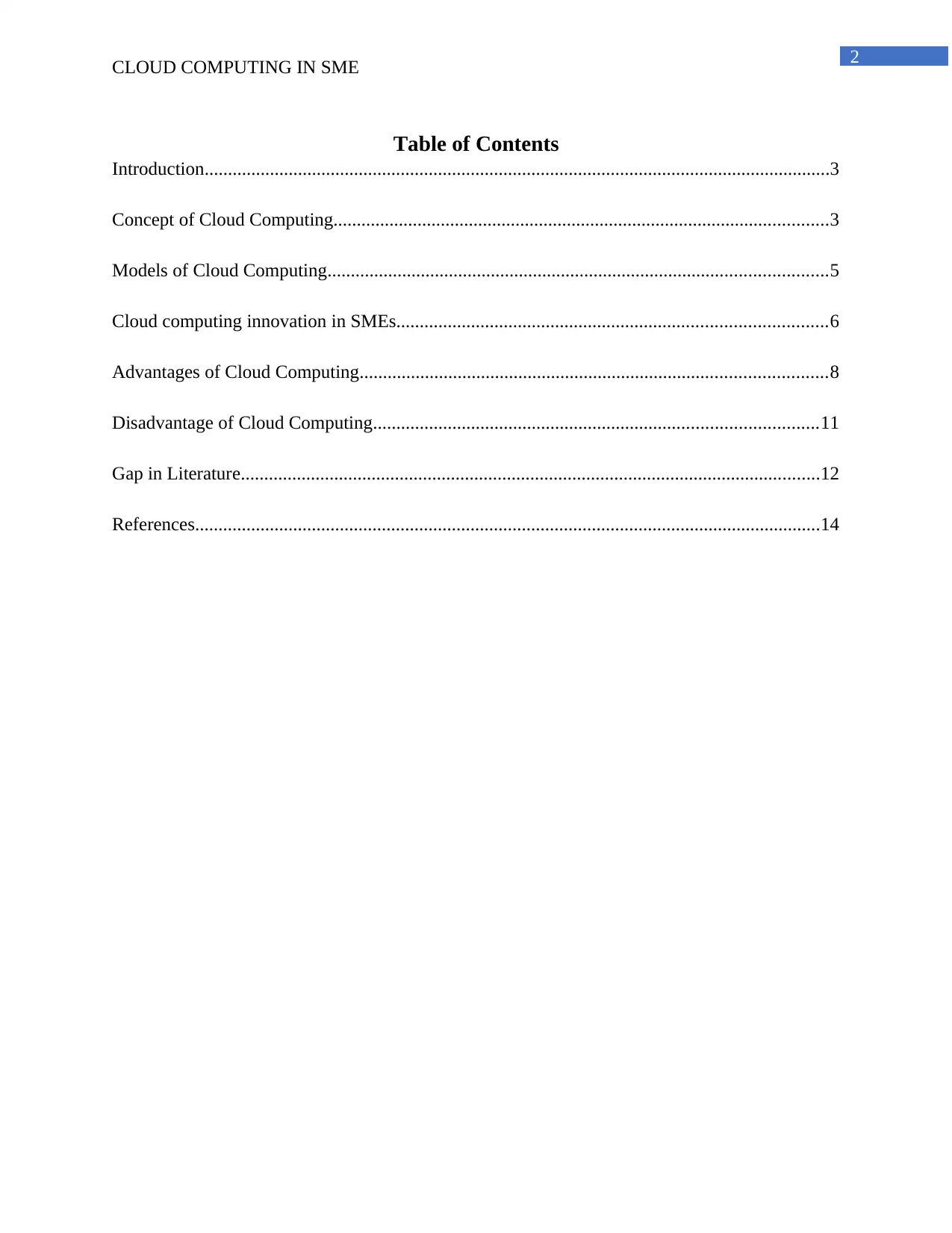
2
CLOUD COMPUTING IN SME
Table of Contents
Introduction......................................................................................................................................3
Concept of Cloud Computing..........................................................................................................3
Models of Cloud Computing...........................................................................................................5
Cloud computing innovation in SMEs............................................................................................6
Advantages of Cloud Computing....................................................................................................8
Disadvantage of Cloud Computing...............................................................................................11
Gap in Literature............................................................................................................................12
References......................................................................................................................................14
CLOUD COMPUTING IN SME
Table of Contents
Introduction......................................................................................................................................3
Concept of Cloud Computing..........................................................................................................3
Models of Cloud Computing...........................................................................................................5
Cloud computing innovation in SMEs............................................................................................6
Advantages of Cloud Computing....................................................................................................8
Disadvantage of Cloud Computing...............................................................................................11
Gap in Literature............................................................................................................................12
References......................................................................................................................................14
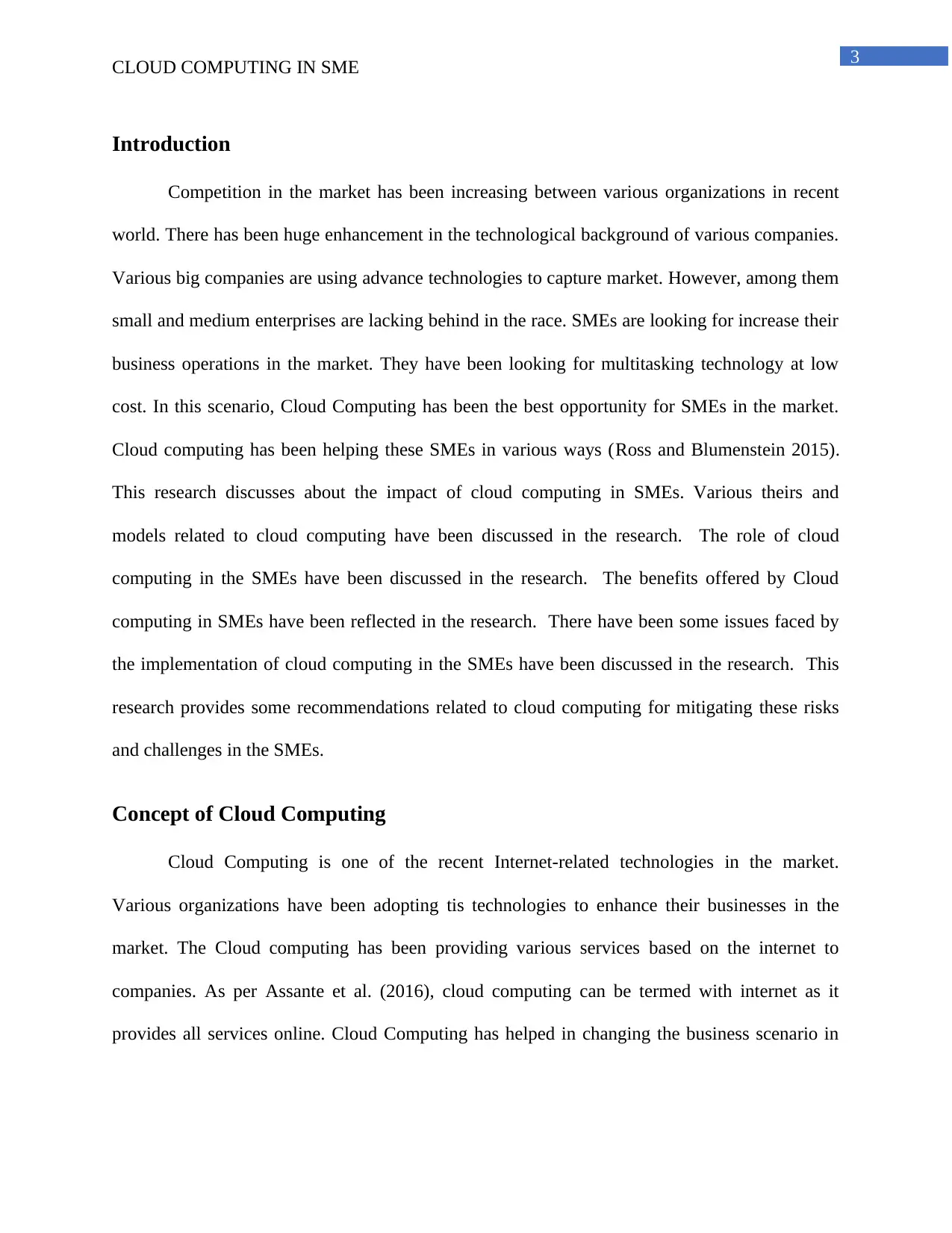
3
CLOUD COMPUTING IN SME
Introduction
Competition in the market has been increasing between various organizations in recent
world. There has been huge enhancement in the technological background of various companies.
Various big companies are using advance technologies to capture market. However, among them
small and medium enterprises are lacking behind in the race. SMEs are looking for increase their
business operations in the market. They have been looking for multitasking technology at low
cost. In this scenario, Cloud Computing has been the best opportunity for SMEs in the market.
Cloud computing has been helping these SMEs in various ways (Ross and Blumenstein 2015).
This research discusses about the impact of cloud computing in SMEs. Various theirs and
models related to cloud computing have been discussed in the research. The role of cloud
computing in the SMEs have been discussed in the research. The benefits offered by Cloud
computing in SMEs have been reflected in the research. There have been some issues faced by
the implementation of cloud computing in the SMEs have been discussed in the research. This
research provides some recommendations related to cloud computing for mitigating these risks
and challenges in the SMEs.
Concept of Cloud Computing
Cloud Computing is one of the recent Internet-related technologies in the market.
Various organizations have been adopting tis technologies to enhance their businesses in the
market. The Cloud computing has been providing various services based on the internet to
companies. As per Assante et al. (2016), cloud computing can be termed with internet as it
provides all services online. Cloud Computing has helped in changing the business scenario in
CLOUD COMPUTING IN SME
Introduction
Competition in the market has been increasing between various organizations in recent
world. There has been huge enhancement in the technological background of various companies.
Various big companies are using advance technologies to capture market. However, among them
small and medium enterprises are lacking behind in the race. SMEs are looking for increase their
business operations in the market. They have been looking for multitasking technology at low
cost. In this scenario, Cloud Computing has been the best opportunity for SMEs in the market.
Cloud computing has been helping these SMEs in various ways (Ross and Blumenstein 2015).
This research discusses about the impact of cloud computing in SMEs. Various theirs and
models related to cloud computing have been discussed in the research. The role of cloud
computing in the SMEs have been discussed in the research. The benefits offered by Cloud
computing in SMEs have been reflected in the research. There have been some issues faced by
the implementation of cloud computing in the SMEs have been discussed in the research. This
research provides some recommendations related to cloud computing for mitigating these risks
and challenges in the SMEs.
Concept of Cloud Computing
Cloud Computing is one of the recent Internet-related technologies in the market.
Various organizations have been adopting tis technologies to enhance their businesses in the
market. The Cloud computing has been providing various services based on the internet to
companies. As per Assante et al. (2016), cloud computing can be termed with internet as it
provides all services online. Cloud Computing has helped in changing the business scenario in
⊘ This is a preview!⊘
Do you want full access?
Subscribe today to unlock all pages.

Trusted by 1+ million students worldwide

4
CLOUD COMPUTING IN SME
the market. There have been various characteristics of cloud computing. Some of the
characteristics are mentioned below:
On-demand self-service: Cloud computing has been helping in providing self-service
portals to users and companies. This help in accessing various products and services over the
cloud database online using the internet.
Rapid Elasticity: The issues in IT resources have been related to elasticity and in-demand
services Cloud computing has been helping in providing elasticity to users (Khan and Al-Yasiri
2016). The resources have been provisioned to users for unlimited access and available in time
when needed.
Resource pooling: The cloud service providers used to merge different IT resources
including memory, storage, and network bandwidth and processing pooled computing resources
for multiple customers.
Figure 1: Basic cloud computing model
(Source: Doherty, Carcary and Conway 2015)
CLOUD COMPUTING IN SME
the market. There have been various characteristics of cloud computing. Some of the
characteristics are mentioned below:
On-demand self-service: Cloud computing has been helping in providing self-service
portals to users and companies. This help in accessing various products and services over the
cloud database online using the internet.
Rapid Elasticity: The issues in IT resources have been related to elasticity and in-demand
services Cloud computing has been helping in providing elasticity to users (Khan and Al-Yasiri
2016). The resources have been provisioned to users for unlimited access and available in time
when needed.
Resource pooling: The cloud service providers used to merge different IT resources
including memory, storage, and network bandwidth and processing pooled computing resources
for multiple customers.
Figure 1: Basic cloud computing model
(Source: Doherty, Carcary and Conway 2015)
Paraphrase This Document
Need a fresh take? Get an instant paraphrase of this document with our AI Paraphraser
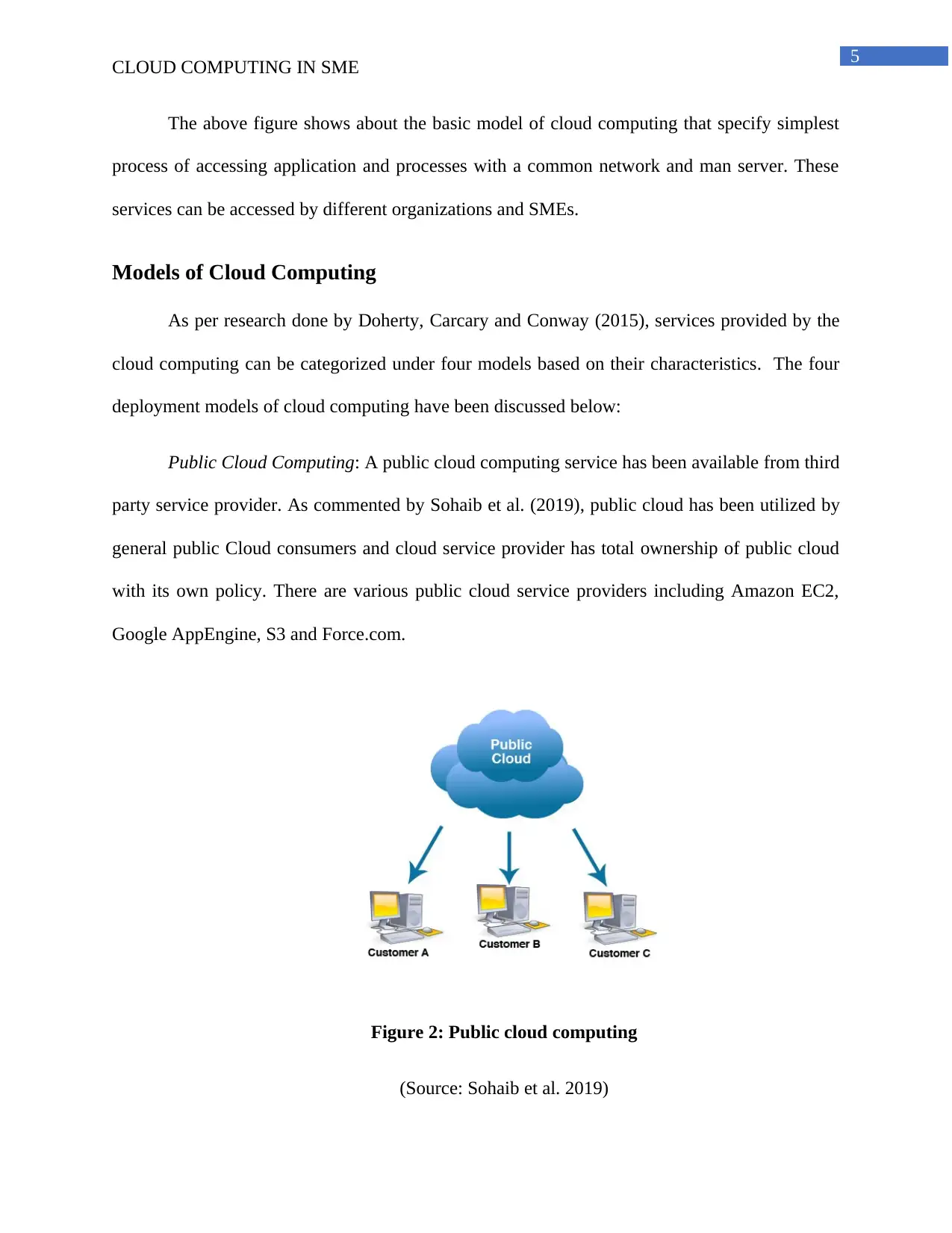
5
CLOUD COMPUTING IN SME
The above figure shows about the basic model of cloud computing that specify simplest
process of accessing application and processes with a common network and man server. These
services can be accessed by different organizations and SMEs.
Models of Cloud Computing
As per research done by Doherty, Carcary and Conway (2015), services provided by the
cloud computing can be categorized under four models based on their characteristics. The four
deployment models of cloud computing have been discussed below:
Public Cloud Computing: A public cloud computing service has been available from third
party service provider. As commented by Sohaib et al. (2019), public cloud has been utilized by
general public Cloud consumers and cloud service provider has total ownership of public cloud
with its own policy. There are various public cloud service providers including Amazon EC2,
Google AppEngine, S3 and Force.com.
Figure 2: Public cloud computing
(Source: Sohaib et al. 2019)
CLOUD COMPUTING IN SME
The above figure shows about the basic model of cloud computing that specify simplest
process of accessing application and processes with a common network and man server. These
services can be accessed by different organizations and SMEs.
Models of Cloud Computing
As per research done by Doherty, Carcary and Conway (2015), services provided by the
cloud computing can be categorized under four models based on their characteristics. The four
deployment models of cloud computing have been discussed below:
Public Cloud Computing: A public cloud computing service has been available from third
party service provider. As commented by Sohaib et al. (2019), public cloud has been utilized by
general public Cloud consumers and cloud service provider has total ownership of public cloud
with its own policy. There are various public cloud service providers including Amazon EC2,
Google AppEngine, S3 and Force.com.
Figure 2: Public cloud computing
(Source: Sohaib et al. 2019)
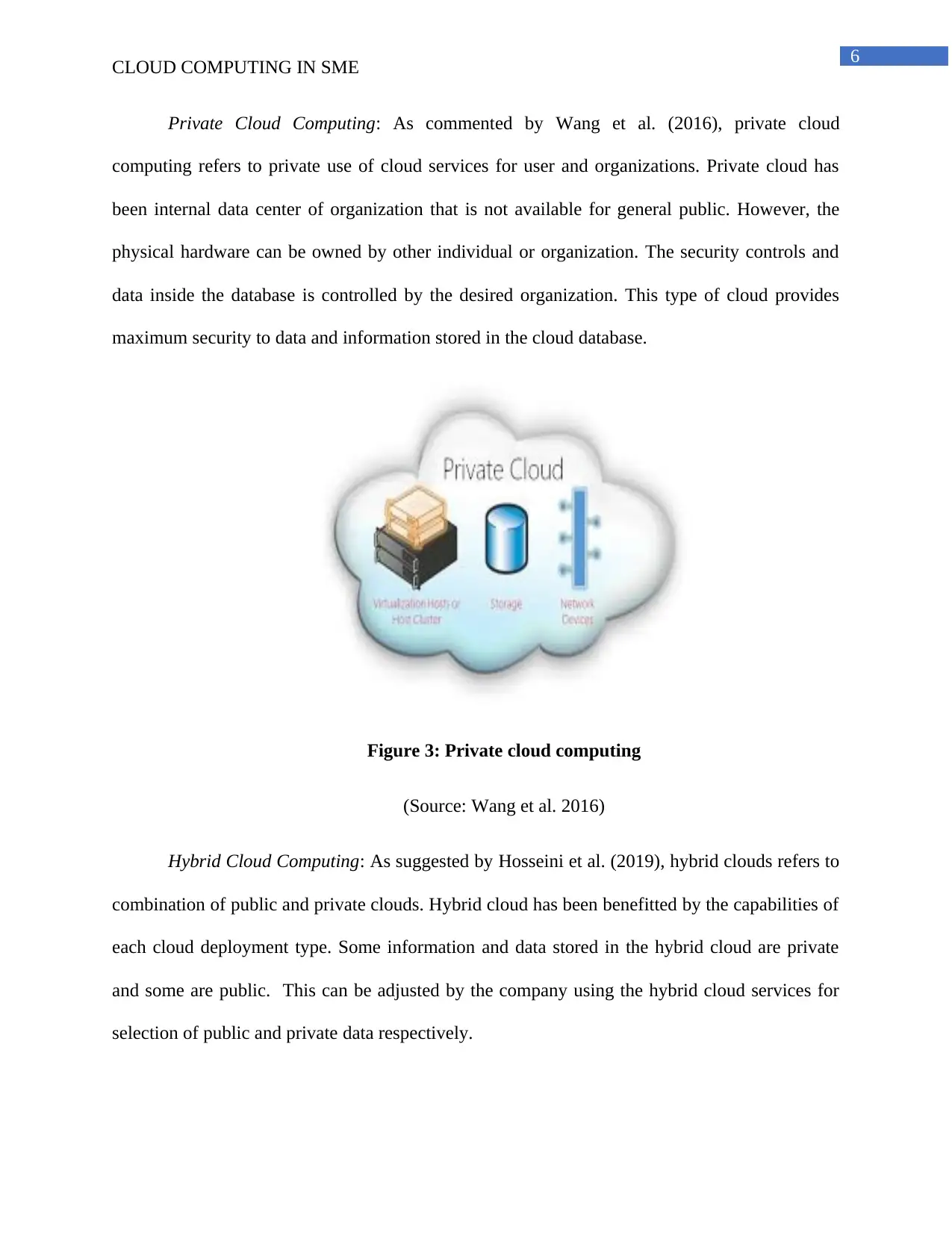
6
CLOUD COMPUTING IN SME
Private Cloud Computing: As commented by Wang et al. (2016), private cloud
computing refers to private use of cloud services for user and organizations. Private cloud has
been internal data center of organization that is not available for general public. However, the
physical hardware can be owned by other individual or organization. The security controls and
data inside the database is controlled by the desired organization. This type of cloud provides
maximum security to data and information stored in the cloud database.
Figure 3: Private cloud computing
(Source: Wang et al. 2016)
Hybrid Cloud Computing: As suggested by Hosseini et al. (2019), hybrid clouds refers to
combination of public and private clouds. Hybrid cloud has been benefitted by the capabilities of
each cloud deployment type. Some information and data stored in the hybrid cloud are private
and some are public. This can be adjusted by the company using the hybrid cloud services for
selection of public and private data respectively.
CLOUD COMPUTING IN SME
Private Cloud Computing: As commented by Wang et al. (2016), private cloud
computing refers to private use of cloud services for user and organizations. Private cloud has
been internal data center of organization that is not available for general public. However, the
physical hardware can be owned by other individual or organization. The security controls and
data inside the database is controlled by the desired organization. This type of cloud provides
maximum security to data and information stored in the cloud database.
Figure 3: Private cloud computing
(Source: Wang et al. 2016)
Hybrid Cloud Computing: As suggested by Hosseini et al. (2019), hybrid clouds refers to
combination of public and private clouds. Hybrid cloud has been benefitted by the capabilities of
each cloud deployment type. Some information and data stored in the hybrid cloud are private
and some are public. This can be adjusted by the company using the hybrid cloud services for
selection of public and private data respectively.
⊘ This is a preview!⊘
Do you want full access?
Subscribe today to unlock all pages.

Trusted by 1+ million students worldwide

7
CLOUD COMPUTING IN SME
Figure 4: Hybrid Cloud computing
(Source: Hosseini et al. 2019)
Community Cloud: As commented by Vidhyalakshmi and Kumar (2016), some
organization used to make a joint Cloud infrastructure that might help both organizations
accordingly. Such type of cloud model is referred to community cloud computing. This cloud
community forms an efficient degree of performance and economic stability in the organizations.
Figure 5: Community cloud computing
(Source: Vidhyalakshmi and Kumar 2016)
CLOUD COMPUTING IN SME
Figure 4: Hybrid Cloud computing
(Source: Hosseini et al. 2019)
Community Cloud: As commented by Vidhyalakshmi and Kumar (2016), some
organization used to make a joint Cloud infrastructure that might help both organizations
accordingly. Such type of cloud model is referred to community cloud computing. This cloud
community forms an efficient degree of performance and economic stability in the organizations.
Figure 5: Community cloud computing
(Source: Vidhyalakshmi and Kumar 2016)
Paraphrase This Document
Need a fresh take? Get an instant paraphrase of this document with our AI Paraphraser
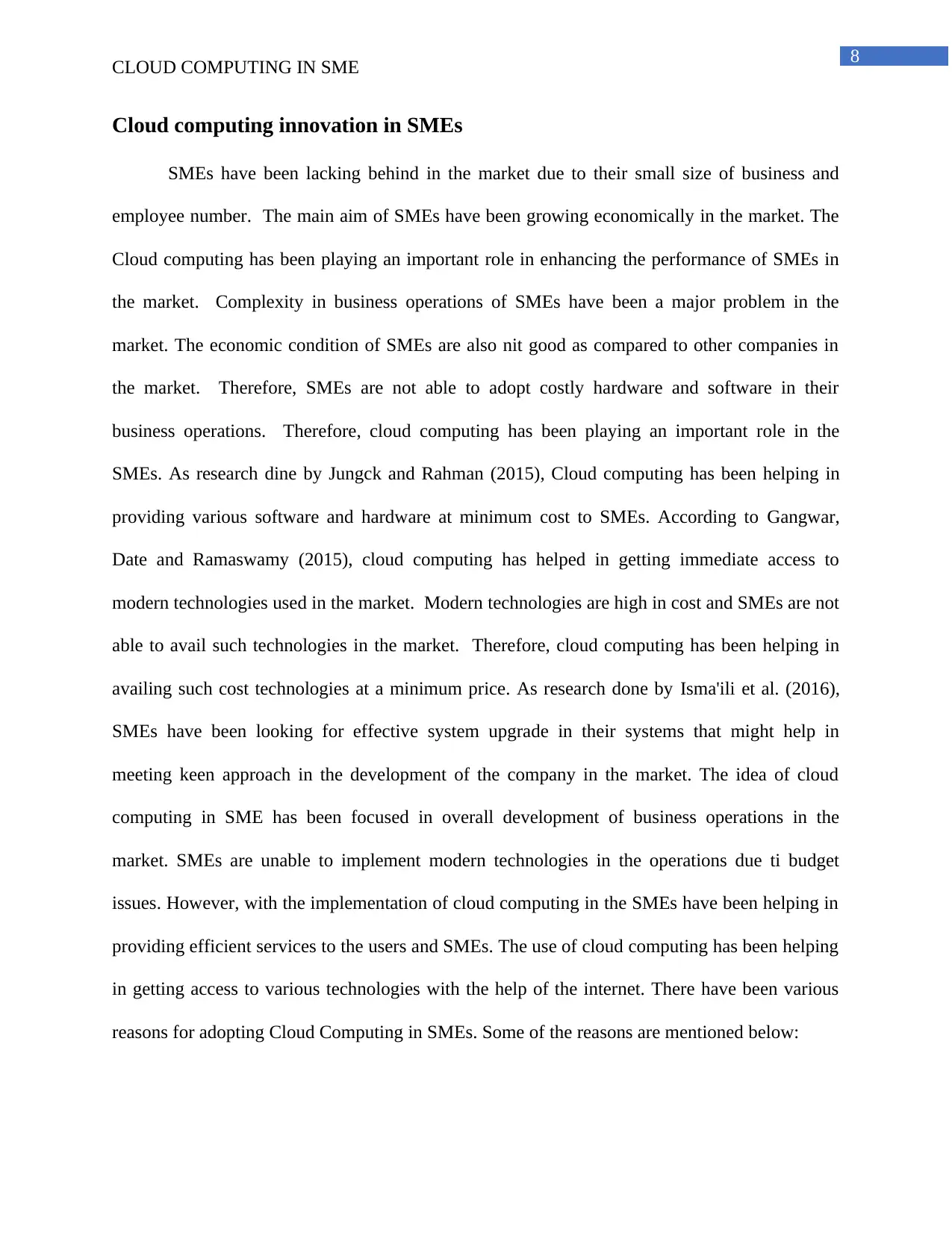
8
CLOUD COMPUTING IN SME
Cloud computing innovation in SMEs
SMEs have been lacking behind in the market due to their small size of business and
employee number. The main aim of SMEs have been growing economically in the market. The
Cloud computing has been playing an important role in enhancing the performance of SMEs in
the market. Complexity in business operations of SMEs have been a major problem in the
market. The economic condition of SMEs are also nit good as compared to other companies in
the market. Therefore, SMEs are not able to adopt costly hardware and software in their
business operations. Therefore, cloud computing has been playing an important role in the
SMEs. As research dine by Jungck and Rahman (2015), Cloud computing has been helping in
providing various software and hardware at minimum cost to SMEs. According to Gangwar,
Date and Ramaswamy (2015), cloud computing has helped in getting immediate access to
modern technologies used in the market. Modern technologies are high in cost and SMEs are not
able to avail such technologies in the market. Therefore, cloud computing has been helping in
availing such cost technologies at a minimum price. As research done by Isma'ili et al. (2016),
SMEs have been looking for effective system upgrade in their systems that might help in
meeting keen approach in the development of the company in the market. The idea of cloud
computing in SME has been focused in overall development of business operations in the
market. SMEs are unable to implement modern technologies in the operations due ti budget
issues. However, with the implementation of cloud computing in the SMEs have been helping in
providing efficient services to the users and SMEs. The use of cloud computing has been helping
in getting access to various technologies with the help of the internet. There have been various
reasons for adopting Cloud Computing in SMEs. Some of the reasons are mentioned below:
CLOUD COMPUTING IN SME
Cloud computing innovation in SMEs
SMEs have been lacking behind in the market due to their small size of business and
employee number. The main aim of SMEs have been growing economically in the market. The
Cloud computing has been playing an important role in enhancing the performance of SMEs in
the market. Complexity in business operations of SMEs have been a major problem in the
market. The economic condition of SMEs are also nit good as compared to other companies in
the market. Therefore, SMEs are not able to adopt costly hardware and software in their
business operations. Therefore, cloud computing has been playing an important role in the
SMEs. As research dine by Jungck and Rahman (2015), Cloud computing has been helping in
providing various software and hardware at minimum cost to SMEs. According to Gangwar,
Date and Ramaswamy (2015), cloud computing has helped in getting immediate access to
modern technologies used in the market. Modern technologies are high in cost and SMEs are not
able to avail such technologies in the market. Therefore, cloud computing has been helping in
availing such cost technologies at a minimum price. As research done by Isma'ili et al. (2016),
SMEs have been looking for effective system upgrade in their systems that might help in
meeting keen approach in the development of the company in the market. The idea of cloud
computing in SME has been focused in overall development of business operations in the
market. SMEs are unable to implement modern technologies in the operations due ti budget
issues. However, with the implementation of cloud computing in the SMEs have been helping in
providing efficient services to the users and SMEs. The use of cloud computing has been helping
in getting access to various technologies with the help of the internet. There have been various
reasons for adopting Cloud Computing in SMEs. Some of the reasons are mentioned below:
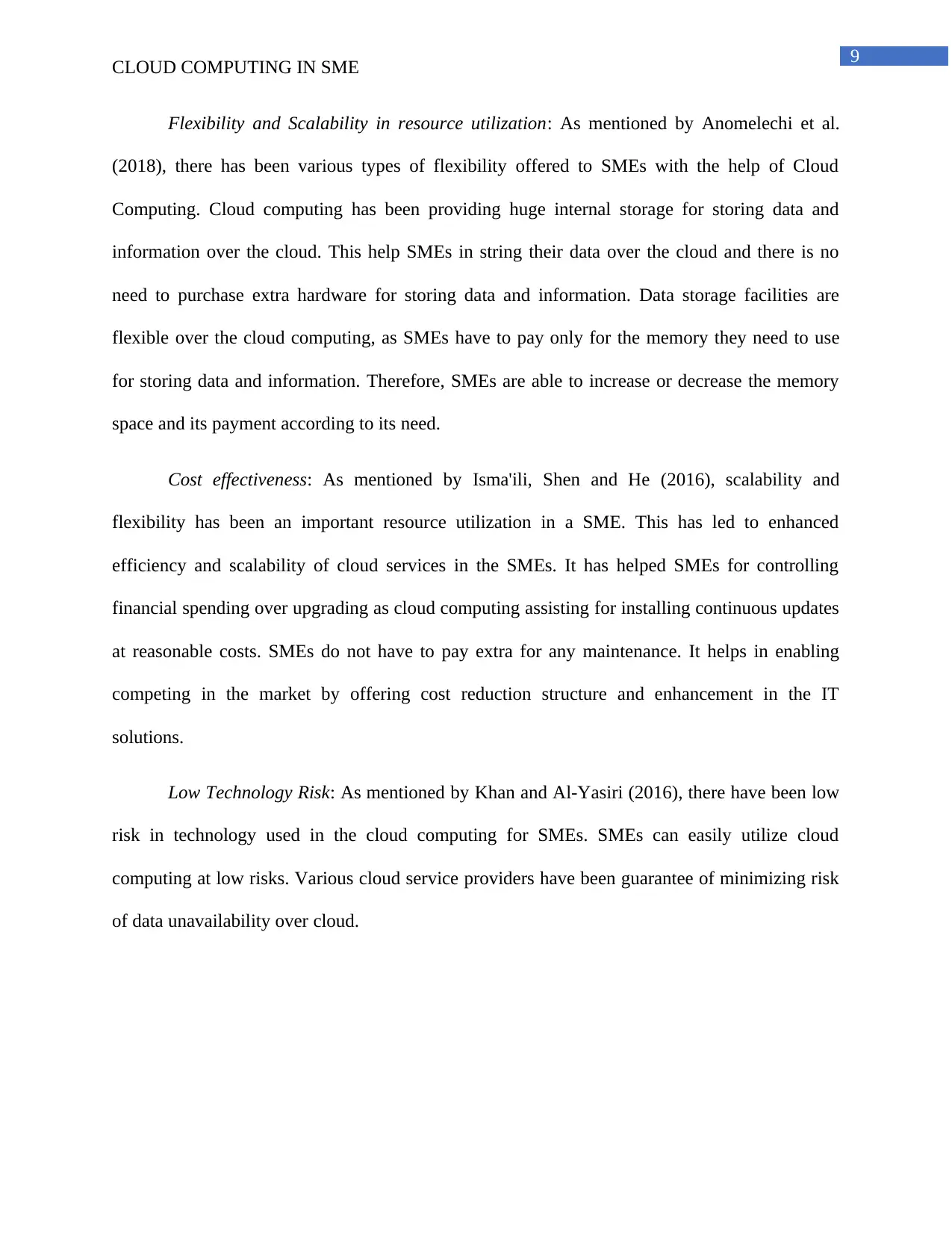
9
CLOUD COMPUTING IN SME
Flexibility and Scalability in resource utilization: As mentioned by Anomelechi et al.
(2018), there has been various types of flexibility offered to SMEs with the help of Cloud
Computing. Cloud computing has been providing huge internal storage for storing data and
information over the cloud. This help SMEs in string their data over the cloud and there is no
need to purchase extra hardware for storing data and information. Data storage facilities are
flexible over the cloud computing, as SMEs have to pay only for the memory they need to use
for storing data and information. Therefore, SMEs are able to increase or decrease the memory
space and its payment according to its need.
Cost effectiveness: As mentioned by Isma'ili, Shen and He (2016), scalability and
flexibility has been an important resource utilization in a SME. This has led to enhanced
efficiency and scalability of cloud services in the SMEs. It has helped SMEs for controlling
financial spending over upgrading as cloud computing assisting for installing continuous updates
at reasonable costs. SMEs do not have to pay extra for any maintenance. It helps in enabling
competing in the market by offering cost reduction structure and enhancement in the IT
solutions.
Low Technology Risk: As mentioned by Khan and Al-Yasiri (2016), there have been low
risk in technology used in the cloud computing for SMEs. SMEs can easily utilize cloud
computing at low risks. Various cloud service providers have been guarantee of minimizing risk
of data unavailability over cloud.
CLOUD COMPUTING IN SME
Flexibility and Scalability in resource utilization: As mentioned by Anomelechi et al.
(2018), there has been various types of flexibility offered to SMEs with the help of Cloud
Computing. Cloud computing has been providing huge internal storage for storing data and
information over the cloud. This help SMEs in string their data over the cloud and there is no
need to purchase extra hardware for storing data and information. Data storage facilities are
flexible over the cloud computing, as SMEs have to pay only for the memory they need to use
for storing data and information. Therefore, SMEs are able to increase or decrease the memory
space and its payment according to its need.
Cost effectiveness: As mentioned by Isma'ili, Shen and He (2016), scalability and
flexibility has been an important resource utilization in a SME. This has led to enhanced
efficiency and scalability of cloud services in the SMEs. It has helped SMEs for controlling
financial spending over upgrading as cloud computing assisting for installing continuous updates
at reasonable costs. SMEs do not have to pay extra for any maintenance. It helps in enabling
competing in the market by offering cost reduction structure and enhancement in the IT
solutions.
Low Technology Risk: As mentioned by Khan and Al-Yasiri (2016), there have been low
risk in technology used in the cloud computing for SMEs. SMEs can easily utilize cloud
computing at low risks. Various cloud service providers have been guarantee of minimizing risk
of data unavailability over cloud.
⊘ This is a preview!⊘
Do you want full access?
Subscribe today to unlock all pages.

Trusted by 1+ million students worldwide
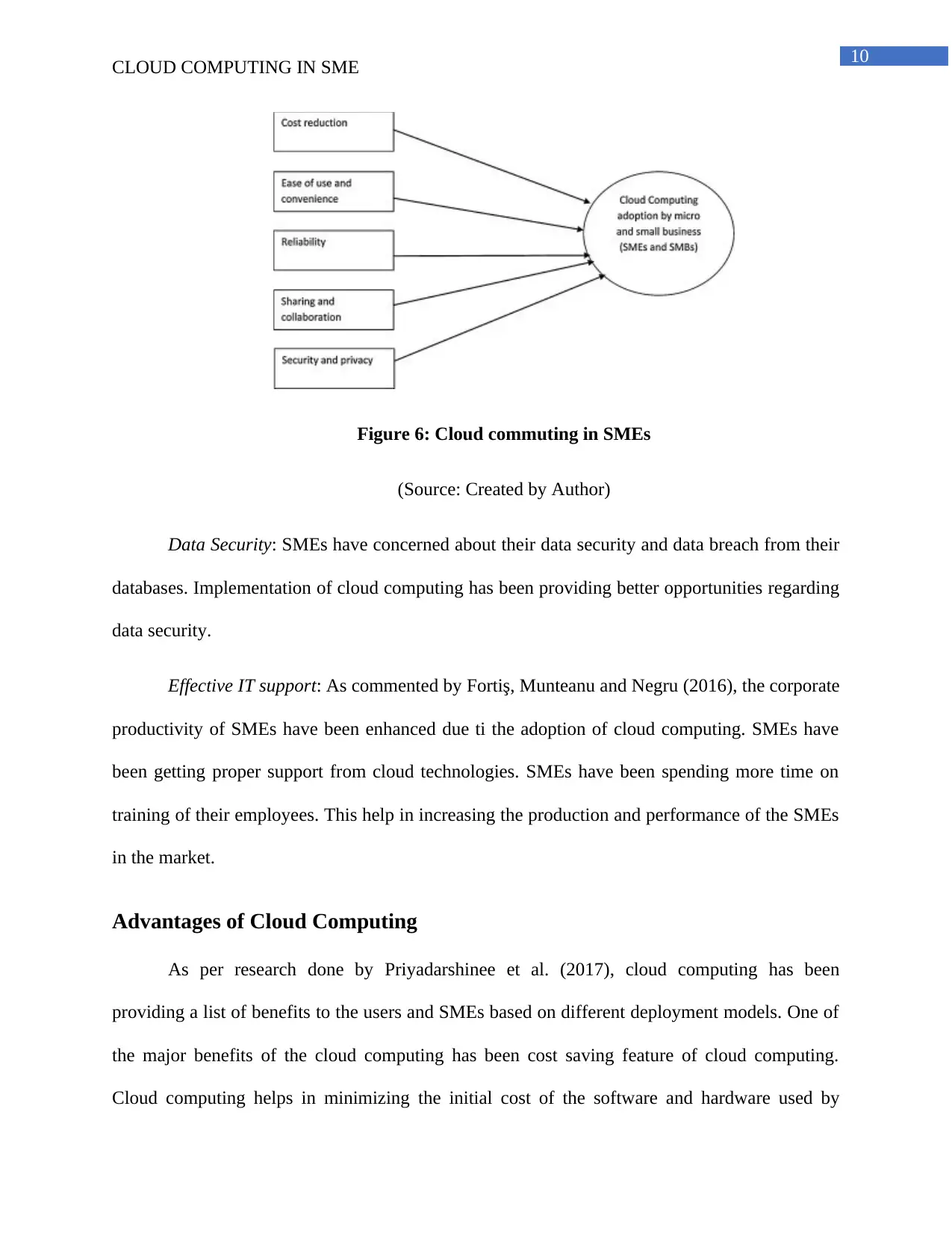
10
CLOUD COMPUTING IN SME
Figure 6: Cloud commuting in SMEs
(Source: Created by Author)
Data Security: SMEs have concerned about their data security and data breach from their
databases. Implementation of cloud computing has been providing better opportunities regarding
data security.
Effective IT support: As commented by Fortiş, Munteanu and Negru (2016), the corporate
productivity of SMEs have been enhanced due ti the adoption of cloud computing. SMEs have
been getting proper support from cloud technologies. SMEs have been spending more time on
training of their employees. This help in increasing the production and performance of the SMEs
in the market.
Advantages of Cloud Computing
As per research done by Priyadarshinee et al. (2017), cloud computing has been
providing a list of benefits to the users and SMEs based on different deployment models. One of
the major benefits of the cloud computing has been cost saving feature of cloud computing.
Cloud computing helps in minimizing the initial cost of the software and hardware used by
CLOUD COMPUTING IN SME
Figure 6: Cloud commuting in SMEs
(Source: Created by Author)
Data Security: SMEs have concerned about their data security and data breach from their
databases. Implementation of cloud computing has been providing better opportunities regarding
data security.
Effective IT support: As commented by Fortiş, Munteanu and Negru (2016), the corporate
productivity of SMEs have been enhanced due ti the adoption of cloud computing. SMEs have
been getting proper support from cloud technologies. SMEs have been spending more time on
training of their employees. This help in increasing the production and performance of the SMEs
in the market.
Advantages of Cloud Computing
As per research done by Priyadarshinee et al. (2017), cloud computing has been
providing a list of benefits to the users and SMEs based on different deployment models. One of
the major benefits of the cloud computing has been cost saving feature of cloud computing.
Cloud computing helps in minimizing the initial cost of the software and hardware used by
Paraphrase This Document
Need a fresh take? Get an instant paraphrase of this document with our AI Paraphraser
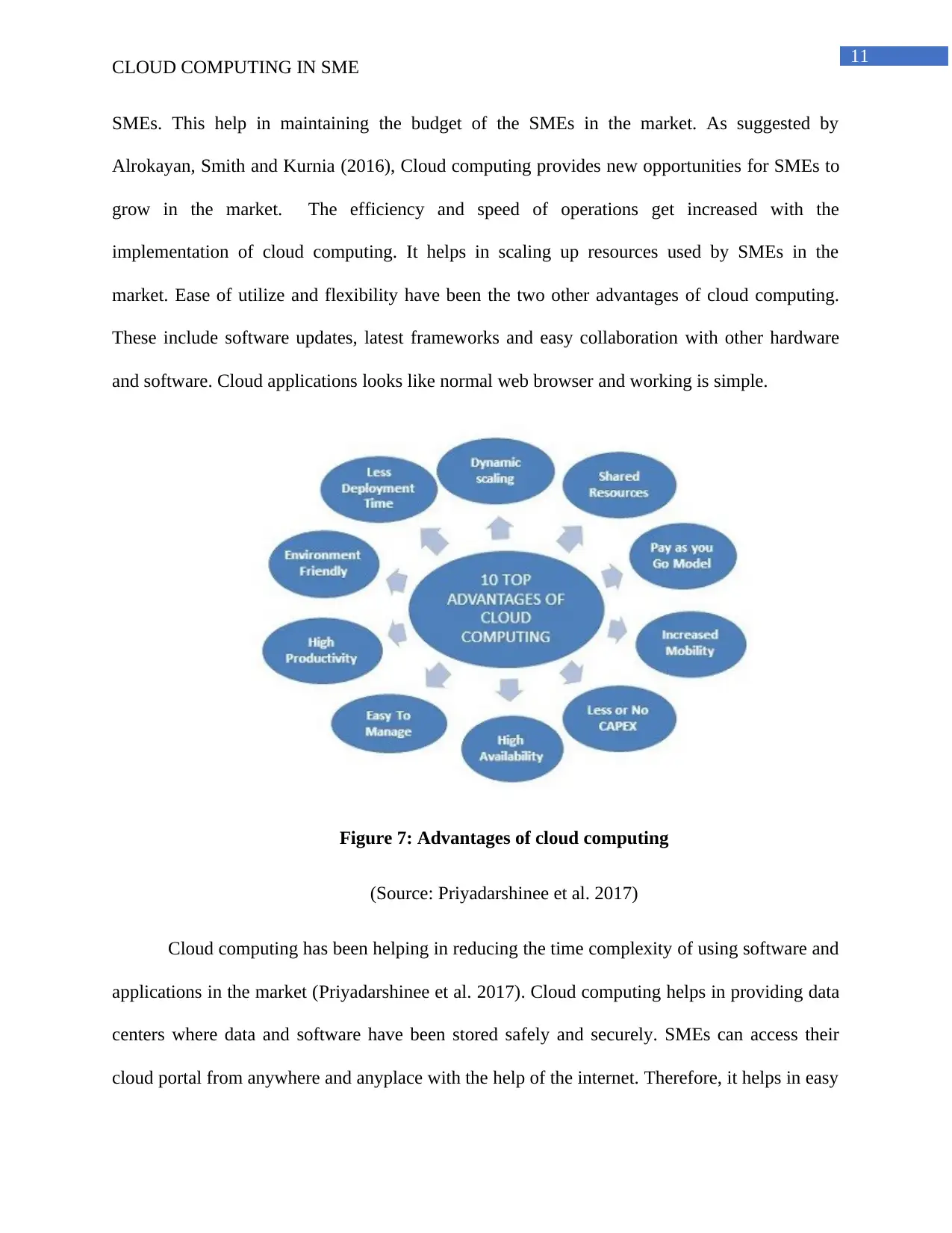
11
CLOUD COMPUTING IN SME
SMEs. This help in maintaining the budget of the SMEs in the market. As suggested by
Alrokayan, Smith and Kurnia (2016), Cloud computing provides new opportunities for SMEs to
grow in the market. The efficiency and speed of operations get increased with the
implementation of cloud computing. It helps in scaling up resources used by SMEs in the
market. Ease of utilize and flexibility have been the two other advantages of cloud computing.
These include software updates, latest frameworks and easy collaboration with other hardware
and software. Cloud applications looks like normal web browser and working is simple.
Figure 7: Advantages of cloud computing
(Source: Priyadarshinee et al. 2017)
Cloud computing has been helping in reducing the time complexity of using software and
applications in the market (Priyadarshinee et al. 2017). Cloud computing helps in providing data
centers where data and software have been stored safely and securely. SMEs can access their
cloud portal from anywhere and anyplace with the help of the internet. Therefore, it helps in easy
CLOUD COMPUTING IN SME
SMEs. This help in maintaining the budget of the SMEs in the market. As suggested by
Alrokayan, Smith and Kurnia (2016), Cloud computing provides new opportunities for SMEs to
grow in the market. The efficiency and speed of operations get increased with the
implementation of cloud computing. It helps in scaling up resources used by SMEs in the
market. Ease of utilize and flexibility have been the two other advantages of cloud computing.
These include software updates, latest frameworks and easy collaboration with other hardware
and software. Cloud applications looks like normal web browser and working is simple.
Figure 7: Advantages of cloud computing
(Source: Priyadarshinee et al. 2017)
Cloud computing has been helping in reducing the time complexity of using software and
applications in the market (Priyadarshinee et al. 2017). Cloud computing helps in providing data
centers where data and software have been stored safely and securely. SMEs can access their
cloud portal from anywhere and anyplace with the help of the internet. Therefore, it helps in easy
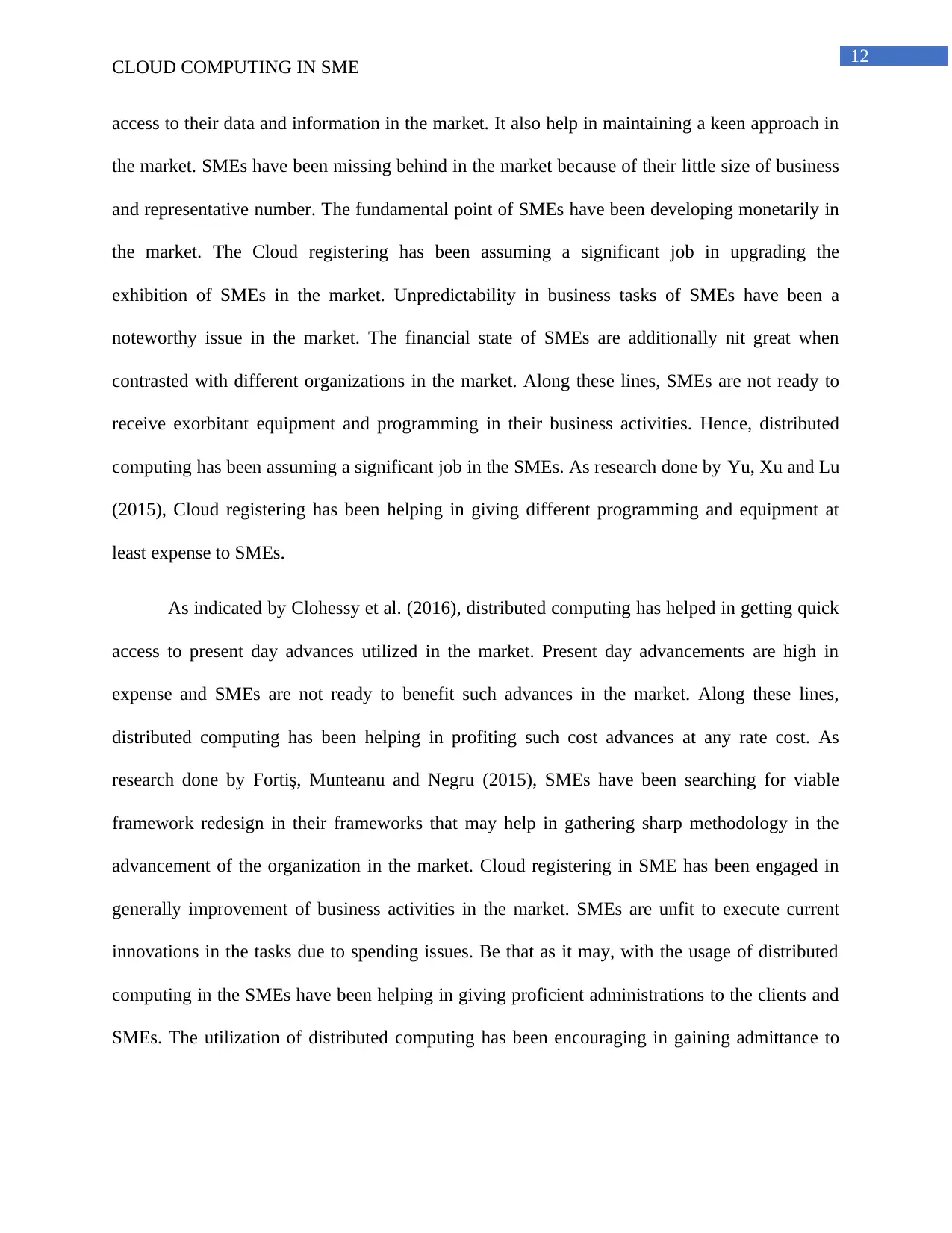
12
CLOUD COMPUTING IN SME
access to their data and information in the market. It also help in maintaining a keen approach in
the market. SMEs have been missing behind in the market because of their little size of business
and representative number. The fundamental point of SMEs have been developing monetarily in
the market. The Cloud registering has been assuming a significant job in upgrading the
exhibition of SMEs in the market. Unpredictability in business tasks of SMEs have been a
noteworthy issue in the market. The financial state of SMEs are additionally nit great when
contrasted with different organizations in the market. Along these lines, SMEs are not ready to
receive exorbitant equipment and programming in their business activities. Hence, distributed
computing has been assuming a significant job in the SMEs. As research done by Yu, Xu and Lu
(2015), Cloud registering has been helping in giving different programming and equipment at
least expense to SMEs.
As indicated by Clohessy et al. (2016), distributed computing has helped in getting quick
access to present day advances utilized in the market. Present day advancements are high in
expense and SMEs are not ready to benefit such advances in the market. Along these lines,
distributed computing has been helping in profiting such cost advances at any rate cost. As
research done by Fortiş, Munteanu and Negru (2015), SMEs have been searching for viable
framework redesign in their frameworks that may help in gathering sharp methodology in the
advancement of the organization in the market. Cloud registering in SME has been engaged in
generally improvement of business activities in the market. SMEs are unfit to execute current
innovations in the tasks due to spending issues. Be that as it may, with the usage of distributed
computing in the SMEs have been helping in giving proficient administrations to the clients and
SMEs. The utilization of distributed computing has been encouraging in gaining admittance to
CLOUD COMPUTING IN SME
access to their data and information in the market. It also help in maintaining a keen approach in
the market. SMEs have been missing behind in the market because of their little size of business
and representative number. The fundamental point of SMEs have been developing monetarily in
the market. The Cloud registering has been assuming a significant job in upgrading the
exhibition of SMEs in the market. Unpredictability in business tasks of SMEs have been a
noteworthy issue in the market. The financial state of SMEs are additionally nit great when
contrasted with different organizations in the market. Along these lines, SMEs are not ready to
receive exorbitant equipment and programming in their business activities. Hence, distributed
computing has been assuming a significant job in the SMEs. As research done by Yu, Xu and Lu
(2015), Cloud registering has been helping in giving different programming and equipment at
least expense to SMEs.
As indicated by Clohessy et al. (2016), distributed computing has helped in getting quick
access to present day advances utilized in the market. Present day advancements are high in
expense and SMEs are not ready to benefit such advances in the market. Along these lines,
distributed computing has been helping in profiting such cost advances at any rate cost. As
research done by Fortiş, Munteanu and Negru (2015), SMEs have been searching for viable
framework redesign in their frameworks that may help in gathering sharp methodology in the
advancement of the organization in the market. Cloud registering in SME has been engaged in
generally improvement of business activities in the market. SMEs are unfit to execute current
innovations in the tasks due to spending issues. Be that as it may, with the usage of distributed
computing in the SMEs have been helping in giving proficient administrations to the clients and
SMEs. The utilization of distributed computing has been encouraging in gaining admittance to
⊘ This is a preview!⊘
Do you want full access?
Subscribe today to unlock all pages.

Trusted by 1+ million students worldwide
1 out of 19
Related Documents
Your All-in-One AI-Powered Toolkit for Academic Success.
+13062052269
info@desklib.com
Available 24*7 on WhatsApp / Email
![[object Object]](/_next/static/media/star-bottom.7253800d.svg)
Unlock your academic potential
Copyright © 2020–2025 A2Z Services. All Rights Reserved. Developed and managed by ZUCOL.





